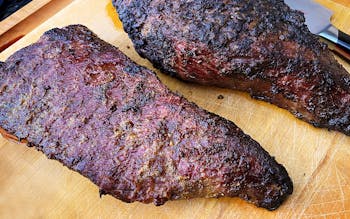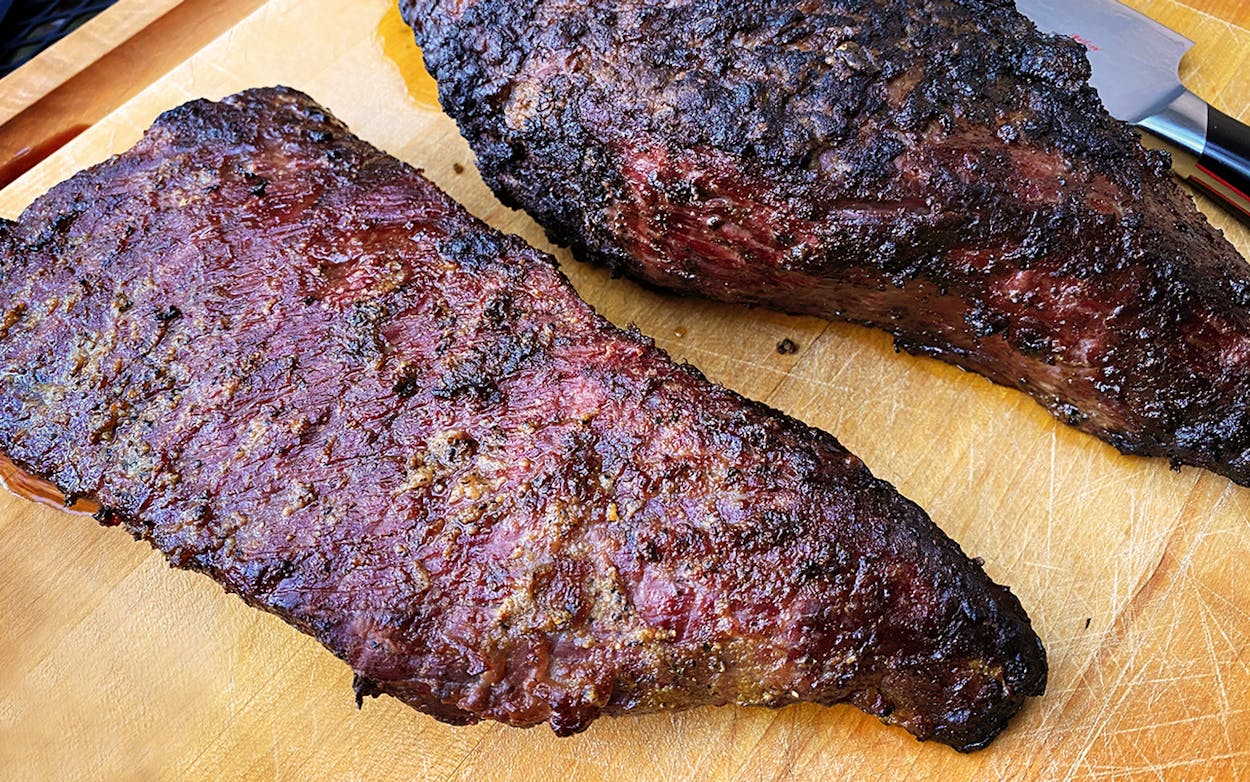Beef prices are at an all-time high. As a result, those restaurants that are open have heavily tilted their menus toward ground beef consumption. Grocery store shoppers are also buying a lot of ground beef, as well as easy-to-prepare steaks like ribeyes, strips, and tenderloins. I asked Jason Schimmels, director of sales at 44 Farms in Cameron, which meats are getting left out of the mix. Tri-tip was the answer (although, ironically, it still hasn’t shown up in their online store).
A cut popular in California, it comes from the bottom sirloin. As its name suggests, tri-tip is triangular in shape. We’ve shown you how to cook it on a two-zone grill set-up, but I wanted to test out a seasoning method. A barbecue joint whose name I won’t divulge said that it bloomed its spices, or briefly cooked them in oil to release the flavors, before applying them to the meat. If you’ve ever cooked Indian food or made a chili recipe that instructed you to add the spices directly into the hot oil, you’ll know the importance of blooming, not to mention the aromas that are released. The ground spices in a barbecue rub are generally applied raw or straight out of the shaker. With a few tri-tips that 44 Farms sent my way, I wanted to try blooming the classic Santa Maria barbecue seasoning combination of garlic powder and ground black pepper before putting it on the meat.


I took two tri-tips, salted them heavily, then let them sit in the fridge, uncovered, for two days. This really pushes the salt flavor deep into the meat. They arrived pretty much untrimmed, with a substantial fat cap. I trimmed one completely clean of fat and left the other intact. Just before putting them on the grill, I seasoned them both with the same ingredients: yellow mustard, canola oil, apple cider vinegar, garlic powder, and black pepper. For one, I made a slurry of the first three ingredients and rubbed it on the meat, then applied the garlic powder and black pepper on top of the slurry. For the other, I bloomed the garlic powder and black pepper in the oil, mixed in the vinegar and mustard, then rubbed it over the tri-tip.
I purposefully used a minimal amount of spice because I wanted to see if the flavor of the bloomed spices, dispersed throughout the oil, would be more apparent than that of the dry spices. I also wanted to check if that full-fat cap would be too thick in the finished product.
I cooked them together on the grill, with all the charcoal piled on one side. I started the tri-tips on the cool side, brought them up to temp, then seared them on the hot side. When checking the internal temperature, remember that this is a thicker cut, and the temperature will continue to rise once the meat is taken off the grill. A tri-tip is also thick, so don’t go right to the cold center to check the temperature. Go in an inch or two off-center. (For the record, I overcooked mine.) It’s important to let the beef rest—I’d suggest for thirty minutes before slicing. If you go in too early, the meat will be too hot, and you’ll watch each slice go from medium-rare to medium-well right before your eyes. Then again, if you have folks who like their meat more well-done, the thin end of the tri-tip will be perfect for them.
As for the final tasting, the salt penetration was great, and I’d recommend keeping the fat cap. The seasoning was a little more noticeable on the “bloomed” version, so I’d try that method again (and bonus: it made the kitchen smell like garlic bread). I also enjoyed the extra tang from the mustard-and-vinegar mix on both.

Smoked Tri-Tip
Equipment
- 1 barbecue grill
Ingredients
- 1 whole, lightly trimmed tri-tip
- kosher salt (variable amount—see note below)
- 1 tablespoon garlic powder
- ½ tablespoon coarse ground pepper
- 2 tablespoons (28 grams) apple cider vinegar
- ¼ cup (62 grams) yellow mustard
- ¼ cup (55 grams) canola oil
Directions
- Season the tri-tip liberally with salt. Use 1.5 percent of the weight of the meat to determine your salt amount if unsure, so 16 ounces of meat would require ¼ ounce (or 7 grams) of salt. I prefer to let them sit in the refrigerator uncovered at least overnight. The ones I tested were in for two full days. Even if you plan to season the meat just before it goes on the grill, apply the salt first, then the other seasonings in a second layer to ensure the salt is even.
- For the rub, mix the garlic powder and black pepper together. In another bowl, whisk together the vinegar and yellow mustard. Heat the oil in a sauté pan. Don’t get it screaming hot, just a nice shimmer on the surface. If the oil is smoking, it’s too hot. Add the spices and stir them in off the heat for just 20 to 30 seconds, being careful not to let them burn. Pour the mustard mix into the pan, but save the bowl. Be careful not to burn yourself. The hot oil may pop, but this step will halt the spices from cooking further. Pour the whole mix back into the mustard bowl, and whisk it together. Slather the entire surface of the tri-tip with the seasoning mixture.
- Once you’re ready to cook, set up your grill for two-zone cooking. Put all the lit charcoal on one half of the grill and the tri-tip on the opposite side. Add some wood chips (I prefer mesquite for a short cook like this one) directly into the charcoal for a good dose of early smoke. Put the lid on the grill with the vent open. Come back in 20 minutes to check the internal temperature, and continue checking every 5 to 10 minutes until the internal temperature reaches 115 degrees (see above for tips on getting a good reading for internal temp).
- Once the proper internal temperature has been reached, move the tri-tip to the hot side of the grill and sear it on all sides. Move to a cutting board and let rest for at least a half hour. With the fat cap still on, you may have to turn it over to find the grain for slicing. Slice the tri-tip thin, against the grain, and serve. The slices from the thin end will be well done, but as you move back into the thick portion it should be medium rare. Serve with a chimichurri or a salsa criolla on the side.
















